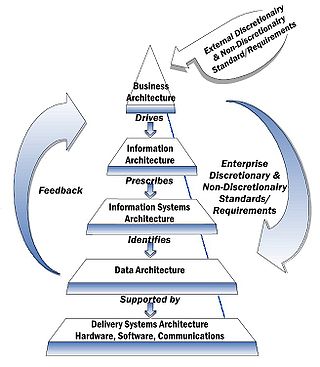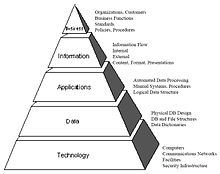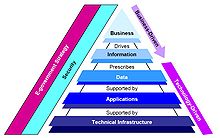- NIST Enterprise Architecture Model
-
 NIST Enterprise Architecture Model.[1]
NIST Enterprise Architecture Model.[1]
NIST Enterprise Architecture Model (NIST EA Model) is a reference model for Enterprise Architecture, that illustrates the interrelationship of enterprise business, information, and technology environments.[1]
This model developed by the National Institute of Standards and Technology (NIST) in 1989, became in the 1990s widely accepted and promoted within the U.S. federal government as an Enterprise Architecture management tool.[1]
This NIST Enterprise Architecture Model is the foundation of several U.S. federal Enterprise Architecture frameworks, for example the Federal Enterprise Architecture Framework.[1]
Contents
Overview
The NIST Enterprise Architecture Model is a five-layered model allows for organizing, planning, and building an integrated set of information and information technology architectures. The five layers are defined separately but are interrelated and interwoven.[1] This interrelation between the architecture layers is defined in the model:[2]
- Business Architecture drives the information architecture
- Information architecture prescribes the information systems architecture
- Information systems architecture identifies the data architecture
- Data Architecture suggests specific data delivery systems, and
- Data Delivery Systems (Software, Hardware, Communications) support the data architecture.
The hierarchy in the model is based on the notion that an organization operates a number of business functions, each function requires information from a number of source, and each of these sources may operation one or more operation systems, which in turn contain data organized and stored in any number of data systems.[3]
History
The origin from the NIST Enterprise Architecture Model was a NIST research project in 1989, published as the NIST Special Publication 500-167, Information Management Directions: The Integration Challenge.[2] In this project two Frameworks were proposed: a Zachman Framework addressing enterprise engineering and a single dimensional classification of subject areas supporting Information Strategy, what latter became known as the NIST Framework. The NIST Framework was picked up by several U.S. federal agencies and used as the basis for their information strategy.[4]
NIST Enterprise Architecture topics
NIST
The U.S. National Institute of Standards and Technology (NIST) is responsible for developing technical, management, physical and administrative standards and guidelines; providing technical assistance; and conducting research for computer systems technology within the Federal government. Two NIST efforts in particular have provided direction to Federal agencies in the development of an open systems environment (OSE) to promote interoperability, portability, scalability, and standardization of agency information architectures and systems.[5]
- Information Management Directions: The Integration Challenge, NIST Special Publication 500-167, September 1989.
- Application Portability Profile (APP) - The U.S. Government’s Open System Environment Profile Version 3.0, NIST Special Publication 500-230, February 1996.
Information Management Directions
 DoE Information Architecture View.[5]
DoE Information Architecture View.[5]
The NIST report entitled "Information Management Directions: The Integration Challenge" defines the Enterprise Architecture, levels within the Architecture, and the standards required to implement and enforce such an Architecture. The NIST Enterprise Architecture has provided a framework for service and agency architecture model definitions. It consists of a five-tiered framework to illustrate business, information, and technology interconnectivity. Although the tiers are separately identified, they are interrelated. An integrated set of information and information technology architectures can be derived from the Enterprise Architecture. In the 1990s the Department of Energy (DOE) has adopted NIST’s Enterprise Architecture model to define its Information Architecture, see image.[5]
Application Portability Profile
The "Application Portability Profile (APP) - The U.S. Government’s Open System Environment Profile Version 3.0" provides recommendations on a set of industry, Federal, national, international and other specifications that define interfaces, services, protocols, and data formats to support an Open System Environment (OSE). The APP addresses the lowest architecture in the NIST Enterprise Architecture Model, i.e., the Delivery System Architecture. Based on these specification recommendations, various services and agencies have defined detailed technical reference models. In the 1990s both the U.S. Patent and Trademark Office (PTO) of the Department of Commerce (DoC) and the Department of Defense (DoD) in its Technical Architecture Framework for Information Management (TAFIM) have defined their Technical Reference Models based on NIST’s APP.[5]
Applications
 FDIC’s Enterprise Architecture Framework.[6]
FDIC’s Enterprise Architecture Framework.[6]
NIST Enterprise Architecture Model is applicated the following frameworks:
- FDIC Enterprise Architecture Framework is the Enterprise Architecture framework of the Federal Deposit Insurance Corporation (FDIC).
- FEAF : The 1999 documentation of the Federal Enterprise Architecture Framework Version 1.1 explains how the NIST Framework is used as a foundation of the FEA Framework.[1]
- NWS Enterprise Architecture : Enterprise Architecture of the National Weather Service[7]
References
 This article incorporates public domain material from websites or documents of the National Institute of Standards and Technology.
This article incorporates public domain material from websites or documents of the National Institute of Standards and Technology.- ^ a b c d e f The Chief Information Officers Council (1999). Federal Enterprise Architecture Framework Version 1.1. September 1999.
- ^ a b Elizabeth N. Fong and Alan H. Goldfine (1989) Information Management Directions: The Integration Challenge. National Institute of Standards and Technology (NIST) Special Publication 500-167, September 1989.
- ^ John O'Looney (2002). Wiring Governments: Challenges and Possibilities for Public Managers. Greenwood Publishing Group. p.67.
- ^ "Exclusive Interview with John Zachman" by Roger Sessions. In: Perspectives of the International Association of Software Architects. April 2006.
- ^ a b c d Federal Aviation Administration (1998) Federal Information Architecture Initiatives. February 1998
- ^ OIG (2005). Implementation of E-Government Principles. May 2005
- ^ Bobby Jones (2003) NWS ENTERPRISE ARCHITECTURE.
External links
- Federal Information Architecture Initiatives in the 1990s.
Categories:- Enterprise architecture
- Reference models
Wikimedia Foundation. 2010.
